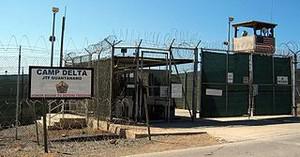Migrant childrenICE looking at housing migrant children at Guantánamo Bay: Report
DHS is considering housing migrant children at the U.S. military prison at Guantanamo Bay to help deal with a sharp increase in the number of immigrants crossing the U.S. southern border. The idea was first proposed earlier this year as DHS looked for military facilities in which to hold undocumented immigrants as they wait for their cases to be processed. There are no immediate plans to bring children to Guantanamo Bay, and officials admit that the optics of housing children next to terrorists would be problematic.

Camp Delta at Guantanamo Bay, Cuba // Source: commons.wikimedia.org
DHS is considering housing migrant children at the U.S. military prison at Guantanamo Bay to help deal with a sharp increase in the number of immigrants crossing the U.S. southern border.
The New York Times reports that the idea was first proposed earlier this year as DHS looked for military facilities in which to hold undocumented immigrants as they wait for their cases to be processed.
The proposal has so far not gained much traction, with officials telling the Times that the idea has been problematic because of the optics of having children being housed right next to terrorism suspects in the notorious American prison camp.
The Times notes that there are no “immediate” plans to bring children to Guantanamo Bay, and that the base has only been brought up as a potential housing location because it has dormitories and other facilities which have been used for asylum seekers in the past.
The Department of Defense has confirmed that military bases are being looked at as potential sites for housing migrants.
The Independent reports that the surge of migrants seen crossing the border into the United States has overwhelmed short-term holding facilities in the southern United States, leaving officials struggling to identify longer-term locations for keeping immigrants coming into the United States.
The capacity problems have been exacerbated, at least in part, by the Trump administration’s decision to resist so-called catch and release program, which allow immigrants to be released into the U.S. general population while awaiting the conclusion of their legal cases.
Immigration and Customs Enforcement (ICE) now has more than 50,000 migrants in its care, one of the highest numbers in its history.
